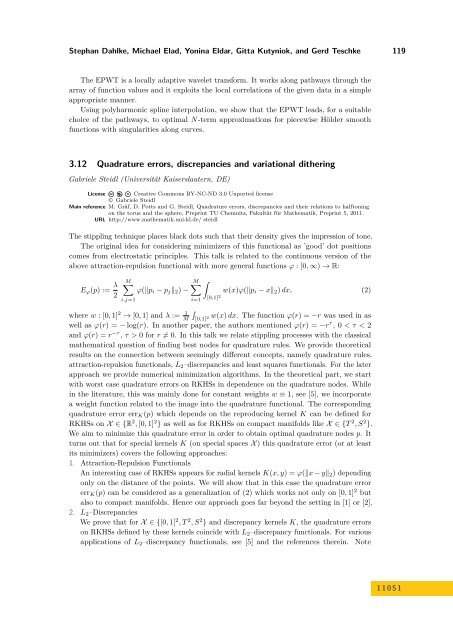Volume 1, Issue 1, January 2011 - DROPS - Schloss Dagstuhl
Volume 1, Issue 1, January 2011 - DROPS - Schloss Dagstuhl
Volume 1, Issue 1, January 2011 - DROPS - Schloss Dagstuhl
You also want an ePaper? Increase the reach of your titles
YUMPU automatically turns print PDFs into web optimized ePapers that Google loves.
Stephan Dahlke, Michael Elad, Yonina Eldar, Gitta Kutyniok, and Gerd Teschke 119<br />
The EPWT is a locally adaptive wavelet transform. It works along pathways through the<br />
array of function values and it exploits the local correlations of the given data in a simple<br />
appropriate manner.<br />
Using polyharmonic spline interpolation, we show that the EPWT leads, for a suitable<br />
choice of the pathways, to optimal N-term approximations for piecewise Hölder smooth<br />
functions with singularities along curves.<br />
3.12 Quadrature errors, discrepancies and variational dithering<br />
Gabriele Steidl (Universität Kaiserslautern, DE)<br />
License Creative Commons BY-NC-ND 3.0 Unported license<br />
© Gabriele Steidl<br />
Main reference M. Gräf, D. Potts and G. Steidl, Quadrature errors, discrepancies and their relations to halftoning<br />
on the torus and the sphere, Preprint TU Chemnitz, Fakultät für Mathematik, Preprint 5, <strong>2011</strong>.<br />
URL http://www.mathematik.uni-kl.de/ steidl<br />
The stippling technique places black dots such that their density gives the impression of tone.<br />
The original idea for considering minimizers of this functional as ’good’ dot positions<br />
comes from electrostatic principles. This talk is related to the continuous version of the<br />
above attraction-repulsion functional with more general functions ϕ : [0, ∞) → R:<br />
Eϕ(p) := λ<br />
2<br />
M�<br />
M�<br />
�<br />
ϕ(�pi − pj�2) −<br />
i,j=1<br />
i=1<br />
[0,1] 2<br />
w(x)ϕ(�pi − x�2) dx, (2)<br />
where w : [0, 1] 2 → [0, 1] and λ := 1<br />
�<br />
M [0,1] 2 w(x) dx. The function ϕ(r) = −r was used in as<br />
well as ϕ(r) = − log(r). In another paper, the authors mentioned ϕ(r) = −rτ , 0 < τ < 2<br />
and ϕ(r) = r−τ , τ > 0 for r �= 0. In this talk we relate stippling processes with the classical<br />
mathematical question of finding best nodes for quadrature rules. We provide theoretical<br />
results on the connection between seemingly different concepts, namely quadrature rules,<br />
attraction-repulsion functionals, L2–discrepancies and least squares functionals. For the later<br />
approach we provide numerical minimization algorithms. In the theoretical part, we start<br />
with worst case quadrature errors on RKHSs in dependence on the quadrature nodes. While<br />
in the literature, this was mainly done for constant weights w ≡ 1, see [5], we incorporate<br />
a weight function related to the image into the quadrature functional. The corresponding<br />
quadrature error errK(p) which depends on the reproducing kernel K can be defined for<br />
RKHSs on X ∈ {R2 , [0, 1] 2 } as well as for RKHSs on compact manifolds like X ∈ {T 2 , S2 }.<br />
We aim to minimize this quadrature error in order to obtain optimal quadrature nodes p. It<br />
turns out that for special kernels K (on special spaces X ) this quadrature error (or at least<br />
its minimizers) covers the following approaches:<br />
1. Attraction-Repulsion Functionals<br />
An interesting case of RKHSs appears for radial kernels K(x, y) = ϕ(�x − y�2) depending<br />
only on the distance of the points. We will show that in this case the quadrature error<br />
errK(p) can be considered as a generalization of (2) which works not only on [0, 1] 2 but<br />
also to compact manifolds. Hence our approach goes far beyond the setting in [1] or [2].<br />
2. L2–Discrepancies<br />
We prove that for X ∈ {[0, 1] 2 , T 2 , S2 } and discrepancy kernels K, the quadrature errors<br />
on RKHSs defined by these kernels coincide with L2–discrepancy functionals. For various<br />
applications of L2–discrepancy functionals, see [5] and the references therein. Note<br />
1 1 0 5 1













